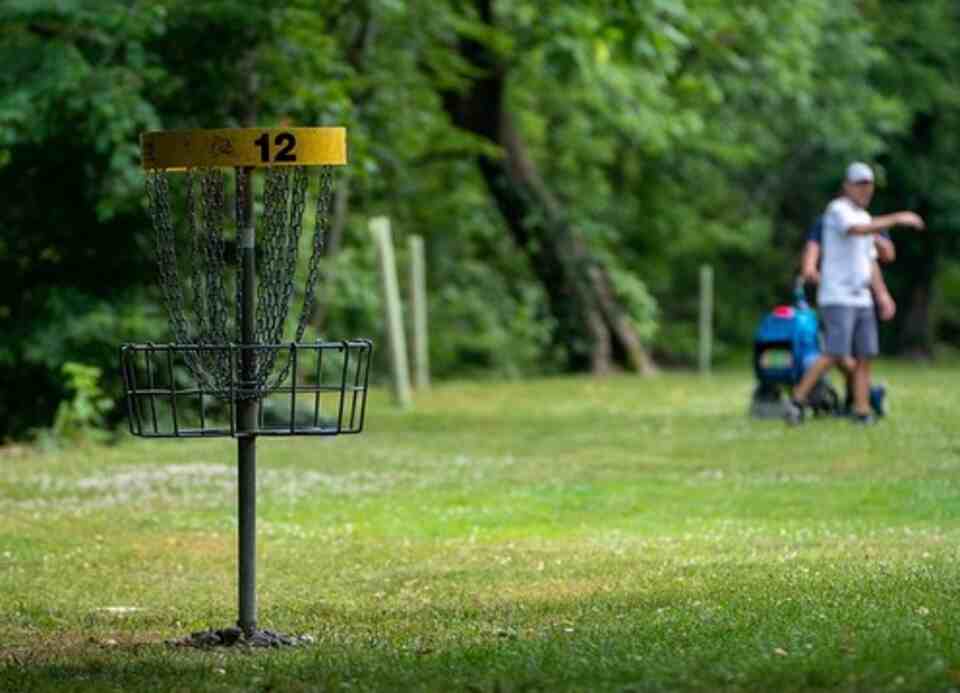Welcome to my guide on mastering the art of throwing a disc golf driver! In this article, I will share essential techniques and tips to help you improve your disc golf throwing skills. Whether you’re a beginner or looking to refine your form, these insights will assist you in perfecting your disc golf driver throw.
Throwing a disc golf driver involves a combination of factors, from grip and hip rotation to arm extension and overall technique. In this first section, we will focus on the fundamentals that will set a solid foundation for your disc golf throwing journey.
Key Takeaways:
- Proper grip is crucial for a successful disc golf driver throw.
- Mastering hip rotation helps generate power and maintain balance.
- The reach back technique allows for more power and velocity in your throws.
- Weight transfer and release point greatly impact distance and accuracy.
- Regular analysis and adjustments to your technique are essential for improvement.

How to Throw a Disc Golf Driver Perfectly?
Mastering the perfect disc golf driver throw requires a balanced stance, proper grip, and a smooth, controlled release. Engage your core, shift your weight from back to front, and unleash the disc with a fluid motion. Practice consistently to refine your technique and achieve maximum distance and accuracy.
Developing the Right Grip
Having the correct grip is essential in disc golf as it directly impacts the accuracy and control of your throws. There are two common grip techniques that players use: the power grip and the modified non-power grip. Let’s take a closer look at each of these grips and their advantages.
Power Grip
The power grip is primarily used for longer drives when maximum distance is desired. To execute the power grip, wrap your hand around the disc with all four fingers pressed against the rim, applying firm pressure. The thumb should be positioned on the flight plate opposite the fingers, providing additional control. This grip allows for a more powerful and controlled release, enabling you to achieve greater distance on your throws.
Modified Non-Power Grip
The modified non-power grip is ideal for shorter drives and approach shots where accuracy and control are crucial. With this grip, place your thumb on the flight plate and curl your fingers underneath the rim, allowing for a looser grip. This grip provides enhanced touch and finesse, allowing you to better navigate tight fairways and finesse shots.
Ultimately, the grip you choose should feel comfortable and natural to you. Experiment with both grips to see which one suits your throwing style and provides optimal control over the disc. Remember, grip is just one aspect of disc golf technique, so make sure to focus on other elements such as body posture and footwork for a well-rounded game.
Now let’s take a look at a comparison table of the power grip and the modified non-power grip:
| Grip Technique | Use | Advantages |
|---|---|---|
| Power Grip | Longer drives | Maximum distance, controlled release |
| Modified Non-Power Grip | Shorter drives, approach shots | Enhanced touch, accuracy, finesse |
Utilizing Good Hip Rotation
When it comes to throwing a disc golf driver with power and accuracy, good hip rotation is essential. Not only does it help generate the necessary power for a long throw, but it also helps maintain balance throughout the throwing motion.
To initiate proper hip rotation, start by bending your knees slightly and lowering your body towards the ground. By doing this, you create a stable base for your throw and allow for a greater range of rotation. Additionally, sticking your butt out slightly further enhances your hip rotation, maximizing the power you generate.
It’s important to practice rotating your hips while maintaining balance. This will ensure that your upper body and arm can follow through smoothly and deliver the disc with accuracy. As you rotate your hips, focus on maintaining a fluid and controlled motion, avoiding any jerky movements that can disrupt your balance and throw off your aim.
Finding Balance:
To help you visualize the importance of hip rotation and maintaining balance, consider the following analogy: think of your body as a powerful engine, and your hips as the transmission that transfers that power to your arm and the disc. Without a properly functioning transmission, the engine’s power is wasted and does not translate into forward motion.
Good hip rotation allows you to unleash the full potential of your throwing motion, generating power that propels the disc forward with speed and precision.
By focusing on hip rotation and balance, you can improve your overall throwing technique, giving you the ability to drive the disc further and with greater accuracy. Practice this fundamental aspect of disc golf throwing, and you’ll be well on your way to mastering the game.
| Key Points | Benefit |
|---|---|
| Proper hip rotation | Generates power for long throws |
| Maintaining balance | Ensures accuracy in the throwing motion |
| Stable base | Provides a foundation for powerful and controlled throws |
| Fluid motion | Delivers the disc with smoothness and precision |
Practice and focus on your hip rotation to unlock the full potential of your disc golf throws. By mastering this fundamental technique, you’ll have the power and balance necessary to achieve greater distance and accuracy on the course.

Perfecting the Reach Back
The reach back is a fundamental element of the disc golf throwing motion, essential for generating power and momentum. It involves reaching back at a 45-degree angle towards the ground and your back leg, setting the foundation for a powerful throw. By maximizing the rotation of your shoulders and hips during the reach back, you can harness more energy and achieve greater distance on your throws.
When executing the reach back, it’s important to maintain a proper extension of your throwing arm. By keeping your arm fully extended during the reach back, you allow for a longer lever motion, resulting in increased acceleration and throwing speed. This extension, combined with the rotational power generated from your hips and shoulders, will translate into a more powerful and accurate throw.
Remember to maintain balance and control throughout the reach back. It’s crucial to find the right balance between a smooth, controlled reach back and maximizing the power generated by your body. Practice this motion consistently to develop muscle memory and ensure a fluid reach back in your disc golf throws.
Key Points for the Reach Back:
- Reach back at a 45-degree angle towards the ground and your back leg
- Maximize rotation of shoulders and hips
- Keep your throwing arm fully extended
- Maintain balance and control
“The reach back sets the stage for a powerful throw in disc golf. By incorporating a 45-degree angle and a fully extended arm, you can unleash the full potential of your throw.” – Disc Golf Pro
| Tip | Benefit |
|---|---|
| Practice reaching back with a slow and controlled motion | Develops muscle memory and ensures consistency in your throws |
| Focus on maintaining balance throughout the reach back | Improves overall control and accuracy in your throws |
| Experiment with different reach back angles to find what works best for you | Allows you to tailor your throw to your own body mechanics and play style |

Focusing on Weight Transfer and Release Point
When it comes to throwing a disc golf driver, mastering weight transfer and finding the right release point are key elements for maximizing distance and accuracy. Proper weight transfer helps generate power and speed, while releasing the disc at the right moment ensures a clean and controlled flight path. In this section, I will discuss the importance of weight transfer and release point in disc golf throws and provide tips on how to improve these aspects of your technique.
Weight Transfer
Weight transfer refers to the movement of your body weight during the throwing motion. To achieve optimal power, it is crucial to shift your weight from your back foot to your front foot as you release the disc. This transfer of weight generates momentum and adds force to your throw. Practice shifting your weight smoothly and explosively to maximize the potential of each throw.
One effective way to improve weight transfer is by focusing on your footwork. Start with a balanced stance, with your feet shoulder-width apart. As you initiate the throwing motion, pivot on your back foot, allowing your hips and shoulders to rotate naturally. As the disc reaches the release point, drive your weight forward onto your front foot, emphasizing the explosive transfer of energy. This motion will help you generate more power and distance in your throws.
Release Point
The release point is the exact moment when you let go of the disc during your throw. It significantly influences the flight path and accuracy of your shot. Aim to release the disc at the apex of your throwing motion, when your arm is fully extended and your wrist snaps forward. This ensures a smooth and clean release, reducing wobble and improving accuracy.
Experiment with different release points to find what works best for you. Visualize the flight path you want to achieve and adjust your release accordingly. For longer throws, try releasing the disc at a slightly higher point, while for shorter, controlled shots, release at a lower point. Consistency is key, so practice releasing the disc at the same point in each throw to develop muscle memory and improve your overall accuracy.
| Weight Transfer Tips | Release Point Tips |
|---|---|
|
|
By focusing on weight transfer and release point, you can take your disc golf throws to the next level. Remember to practice these techniques consistently to develop muscle memory and improve your overall throwing skills. In the next section, I will discuss the importance of analyzing and adjusting your technique to optimize your performance on the course.
Analyzing and Adjusting Technique
When it comes to improving your disc golf skills, analyzing and adjusting your technique is essential. By reviewing your throws and making small adjustments, you can optimize your performance on the course. Regularly recording your throws and reviewing the footage allows you to identify areas for improvement and track your progress over time.
One key aspect of technique analysis is to focus on your grip. Experiment with different grips to find the one that offers the best control and comfort for your throws. Additionally, pay attention to your body positioning and alignment during the throw. Adjusting your posture and stance can greatly impact the accuracy and power of your throws.
“Analyzing my technique has been a game-changer for me. I was able to identify that my grip was too tight, causing my throws to veer off course. Making adjustments to my grip pressure has greatly improved my accuracy and consistency.” – Disc golfer
Table: Grip Analysis
| Grip Technique | Advantages | Disadvantages |
|---|---|---|
| Power Grip | – Offers maximum control and power for long drives – Allows for a strong release | – May be less comfortable for some players – Requires hand strength and flexibility |
| Modified Non-Power Grip | – Provides better control for shorter drives and approach shots – Can be more comfortable for players with smaller hands | – May sacrifice some power and distance – Requires adjustment for longer drives |
In addition to grip analysis, consider working with a coach or experienced disc golfer who can provide valuable feedback and guidance. They can help identify any flaws or inconsistencies in your technique that may hinder your progress. Finally, be patient and persistent in your practice. Technique adjustments take time to refine, but with dedication and practice, you can elevate your disc golf game to new heights.
Mastering the S-Curve Throw
Mastering the S-curve throw in disc golf can take your game to new heights, allowing you to achieve greater distance and control over your throws. The S-curve throw follows a curved flight path, resembling the letter ‘S’, and is a valuable technique to have in your repertoire. Let’s explore the key elements of executing the S-curve throw.
Technique
To execute the S-curve throw, it is important to release the disc with a slight anhyzer angle. This means angling the outer edge of the disc slightly upward, allowing it to turn right before gradually fading back to the left. The anhyzer angle initiates the desired flight path, creating the distinctive ‘S’ shape.
Focus on a smooth and controlled release, ensuring you apply enough power to generate the desired flight pattern. It may take some practice to perfect the timing and angle of your release, but with dedication, you can master this technique.
Benefits
The S-curve throw offers several advantages on the course. By utilizing this technique, you can navigate obstacles more effectively, such as trees or elevated terrain. The curved flight path allows the disc to circumvent obstacles and reach your target with greater precision.
Additionally, the S-curve throw can provide increased distance compared to a straight throw. The combination of the anhyzer angle and the gradual fade back to the left can generate extra momentum and carry, resulting in a longer throw.
Practice and Application
To incorporate the S-curve throw into your game, dedicate time to practicing the technique. Start by experimenting with different release angles and power levels to understand the flight characteristics of your discs. Adjust your grip and body mechanics as needed to achieve the desired flight path.
Once you have mastered the technique, consider where and when to use the S-curve throw strategically. Assess the course layout and identify opportunities where the curved flight path can provide a competitive advantage. With practice and experience, you will become more adept at executing the S-curve throw in various situations.
Remember, the S-curve throw is a versatile technique that can elevate your disc golf game. Add it to your arsenal of throws and enjoy the benefits of increased control and distance on the course.

Incorporating Hyzer and Anhyzer Angles
Understanding and utilizing hyzer and anhyzer angles in disc golf can provide you with strategic shot-making options. These throwing techniques allow you to control the flight path of the disc and navigate various obstacles on the course. The hyzer angle is achieved by releasing the disc with the outer edge angled downward, causing it to curve to the left for right-handed players. On the other hand, the anhyzer angle is created by releasing the disc with the outer edge angled upward, making it curve to the right for right-handed players.
By incorporating hyzer and anhyzer angles into your throws, you can effectively shape your shots to suit different situations. When faced with a tight fairway or a dogleg to the left, using a hyzer angle can help you navigate the course and land the disc in the desired location. Conversely, when you need to make a shot that curves to the right or avoid obstacles on the right side of the fairway, employing an anhyzer angle can be advantageous.
To execute hyzer and anhyzer throws, it is important to practice and refine your technique. Experiment with different release angles and observe how they affect the flight of the disc. Adjusting the angle of your wrist and the orientation of the disc can also influence the amount of curve in your shots. Take note of the wind conditions as well, as they can further affect the flight path of the disc when throwing with hyzer or anhyzer angles.
Mastering these angles will expand your shot choices on the course and give you more control over your throws. By becoming proficient in utilizing hyzer and anhyzer angles, you can enhance your overall disc golf skills and improve your performance in various playing conditions.
Developing Finesse Shots
When it comes to disc golf, finesse shots can be a game-changer in challenging situations. These specialty throws, such as rollers and skip shots, allow players to navigate obstacles and achieve greater control over their throws. Let’s explore these advanced techniques that can take your disc golf game to the next level.
Rollers: Unleashing the Power of Ground Game
Rollers involve throwing the disc at a sharp angle, causing it to roll along the ground, covering a great distance. This technique is particularly useful when you encounter dense vegetation, elevated obstacles, or windy conditions. By utilizing a roller, you can effectively maneuver around trees and other barriers, giving you a strategic advantage on the course. Practice adjusting the angle and release speed to control the direction and distance of your rollers. Mastering this finesse shot can help you overcome challenging situations and reach your target with precision.
Skip Shots: Harnessing the Art of Ground Skipping
Skip shots are designed to fly low and fast, allowing the disc to skip off the ground and continue its flight path. This technique is useful when you need to clear water hazards, maneuver around tight fairways, or reach distant targets. By intentionally causing the disc to skip, you can bypass obstacles and gain additional distance. Experiment with different angles and release points to achieve the desired skip effect. Developing this finesse shot will enhance your shot-making options and enable you to navigate challenging course layouts with confidence.
| Finesse Shot | Description |
|---|---|
| Rollers | Throwing the disc at a sharp angle to roll along the ground |
| Skip Shots | Low and fast throws that allow the disc to skip off the ground |
Specialty Throws: Expanding Your Disc Golf Arsenal
In addition to rollers and skip shots, disc golf offers a variety of specialty throws that can be utilized in specific situations. These throws include thumbers, tomahawks, forehand rollers, and grenade shots. Thumbers and tomahawks are overhand throws that provide versatility in navigating obstacles and achieving unique flight paths. Forehand rollers involve rolling the disc on its edge using a forehand throw, while grenade shots are high-arcing throws with a steep descent. Each of these throws requires practice and finesse to master, but once perfected, they can give you a competitive edge on the course.
By developing finesse shots in disc golf, such as rollers, skip shots, and specialty throws, you can elevate your game to new heights. These techniques provide you with strategic options to overcome obstacles, reach challenging targets, and surprise your opponents. Embrace the art of finesse and enjoy the excitement of mastering these advanced techniques.
Conclusion:
By following these tips and techniques for throwing a disc golf driver, you can significantly improve your skills and performance on the course. Focus on developing a proper grip that allows you to maintain control over the disc, ensuring a solid foundation for your throws. Pay attention to hip rotation, generating power and maintaining balance throughout your throwing motion. This will help you maximize distance and accuracy.
Remember to reach back at a 45-degree angle and extend your throwing arm for greater power and velocity. Transfer your weight from your back foot to your front foot during the throw to generate more power and speed. Pay attention to the release point, aiming to release the disc smoothly and consistently at the apex of your throwing motion for improved accuracy.
Regularly analyze and adjust your technique to optimize your performance. Reviewing footage of your throws can help you identify areas for improvement. Make small adjustments, such as grip or body positioning, and continue practicing to refine your skills. Additionally, consider incorporating advanced techniques like the S-curve throw and utilizing hyzer/anhyzer angles to expand your shot choices on the course.
With practice and dedication, you can become a skilled disc golfer. Keep honing your skills, fine-tuning your technique, and exploring new shots. The more you embrace the game and invest time into improving your skills, the more rewarding your disc golf experience will become.
FAQ
What grip should I use for throwing a disc golf driver?
You can choose between the power grip and the modified non-power grip, depending on the type of throw you want to make. The power grip is ideal for longer drives, while the modified non-power grip is better for shorter drives and approach shots. Use the grip that feels comfortable and allows you to maintain control over the disc.
How can hip rotation improve my disc golf throw?
Hip rotation is important for generating power and maintaining balance during a throw. By bending at the knees, lowering your body towards the ground, and sticking your butt out slightly, you can increase your rotation and generate more power. Practice rotating your hips while maintaining balance to improve your overall throwing technique.
What is the reach back in disc golf throwing?
The reach back is an essential part of the throwing motion in disc golf. It involves reaching back at a 45-degree angle towards the ground and your back leg to generate momentum. The more rotation you can achieve before your throw, the greater reach back you can have. This extension of the throwing arm allows for more power and velocity on the throw.
How can weight transfer and release point affect my disc golf throws?
Weight transfer and release point are crucial for increasing distance and accuracy in disc golf throws. Shift your weight from your back foot to your front foot during the throw to generate more power and speed. Aim to release the disc smoothly and consistently at the apex of your throwing motion for improved accuracy. Practice these techniques to enhance your overall throwing skills.
How can I analyze and adjust my disc golf technique?
Regularly analyzing and adjusting your disc golf technique can optimize your performance. Record your throws and review the footage to identify areas for improvement. Make small adjustments, such as grip or body positioning, and continue practicing to refine your skills. Constantly working on your technique will help you become a better disc golfer.
What is the S-curve throw in disc golf?
The S-curve throw is a technique that can maximize distance and control in disc golf. It involves throwing the disc on a curved flight path, resembling the letter ‘S.’ To execute the S-curve, release the disc with a slight anhyzer angle, allowing it to turn right before gradually fading back to the left. Practice this technique to elevate your throwing abilities.
How can hyzer and anhyzer angles be used in disc golf?
Hyzer and anhyzer angles in disc golf provide strategic shot-making options. A hyzer throw is released with the disc’s outer edge angled downward, causing it to curve to the left for right-handed players. An anhyzer throw is released with the outer edge angled upward, making the disc curve to the right for right-handed players. Mastering these angles will expand your shot choices on the course.
What are finesse shots in disc golf?
Finesse shots, such as rollers and skip shots, are advanced techniques that can give you an advantage in challenging situations. Rollers involve throwing the disc at a sharp angle so that it rolls along the ground, covering a great distance. Skip shots involve throwing the disc low and fast, allowing it to skip off the ground and continue flying. Practice these advanced techniques to navigate difficult obstacles and improve your overall game.


